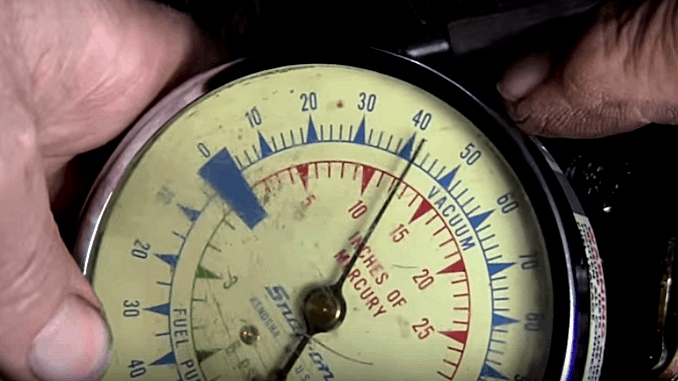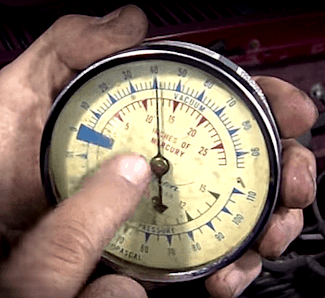How to Interpret Vacum Gauge Readings Pics

Vacuum gauges have been a valuable tool to mechanics for years, and one of the easiest and cheapest ways to cheque an engine for serious issues is to perform a vacuum estimate test.
Fifty-fifty with modern reckoner-controlled engines, a vacuum gauge is nonetheless a valuable tool for diagnosing engine and transmission issues. Yous can make up one's mind whether or non an engine is good for you in only several minutes.
Vacuum Guess Engine Testing

A vacuum exam shows the difference between exterior atmospheric pressure and the amount of vacuum present in the intake manifold. Piston rings, valves, ignition arrangement, and the fuel arrangement all affect how much vacuum is created, equally well as other parts that may touch on the combustion process (emissions devices, etc.).
Each has a characteristic effect on the running of the engine and you lot judge operation/issues past watching variations from normal. It is important to judge engine performance by the general location and action of the needle on a vacuum gauge, rather than by a single reading.
Evaluate operation past watching variations from normal. It is of import to evaluate engine performance by the general location and action of the vacuum gauge rather than just past a vacuum reading itself. A vacuum approximate can assistance decide engine state or problems, including the following:
Normal Engine Performance
At idle, an engine should evidence a steady vacuum reading between 17″ and 21″. A quick opening and closing of the throttle should cause the vacuum to drop below 5″ and then rebound to 21″, or more than.
General Ignition Issues or Viscous Valves
With the engine idling, continued fluctuation of 1 to 2 inches may signal an ignition problem. Check the spark plugs, spark plug gap, master ignition circuit, high tension cables, distributor cap, or ignition ringlet. Fluctuations of 3 to 4 inches may indicate sticky valves.
Intake System Leakage, Valve Timing, or Low Compression
Vacuum readings at idle that are much lower than normal can indicate leaky intake manifold gaskets, manifold-to-carburetor gaskets, vacuum brakes, or the vacuum modulator. Low readings could as well be very belatedly valve timing or worn piston rings.
Exhaust Dorsum Pressure level
Starting with the engine at idle, slowly increase engine speed to 3,000 RPM, engine vacuum should be equal to or higher than idle vacuum at 3,000 RPM. If vacuum decreases at higher engine RPMs, excessive frazzle backpressure is likely present.
Cylinder Head Gasket Leakage
With the engine Idling, the vacuum judge indicator volition sharply drop every time the leak occurs. The driblet will be from the steady reading shown past the pointer to a reading of x″ to 12″, or less. If the leak Is between two cylinders, the drop will be much greater. Decide the location of the leak by performing a compression exam.
Fuel Control System Troubles
All other systems in an engine must be performance properly earlier you cheque the fuel control organization every bit a cause for poor engine performance. If the arrow has a boring floating motion of iv to 5 inches – you should bank check the fuel command.
A Annotation Virtually Diagnosing Transmission Issues
An important role of transmission diagnosis is to make certain the engine operates properly. If the engine performance is incorrect, the transmission will receive the wrong information. Many times what is perceived as a transmission problem is actually an engine problem.
The engine sends signals to the transmission through a vacuum line, throttle cable, or both. These signals basically synchronize torque with transmission line pressure, shift feel, and shift timing. Malfunctions in items like the air filter; spark plugs, EGR valves, and other parts of the fuel, electric, and emission systems could result in improper transmission functioning.
How To Connect a Vacuum Gauge and Perform a Vacuum Exam
To cheque manifold pressure with a vacuum gauge, you will demand to locate a port in the manifold or throttle body. Manufacturers install ports on their manifolds for the Restriction Booster, PCV tube, EGR Switch, A/C vents, etc. Notice one for the vacuum gauge line to be inserted into firmly.
NOTE: Vacuum readings will vary according to the distance in different localities. From sea level to two,000 anxiety elevation all normal engines should show a vacuum reading between 17 to 21 inches. Higher up 2,000 feet acme, the vacuum reading will be about one (1) inch lower per each 1,000 anxiety rise in elevation.
Vacuum Gauge Readings and Meanings
Vacuum Estimate Engine Status Indicators
| Engine Speed | Vacuum Gauge Reading | Indication of Engine Status |
|---|---|---|
| Smooth and steady idle (800 to 1200 RPM) | Between 17 to 21 inches | The engine is in Good Condition, merely perform the next test to be sure. |
| Open and close throttle apace | Jumps from two to nigh 25 inches | The engine is in Good Condition. |
| Smooth and steady idle | Steady, but lower than normal reading | Worn rings, but perform the side by side test to be sure. |
| Open and close throttle rapidly | Jumps from 0 to 22 inches | Confirms worn rings. |
| Steady idle | Intermittent dropping back three or five divisions and returns to normal | Sticky Valves. If injection of penetrating oil into intake manifold temporarily stops arrow from dropping back, it'due south certain the valves are sticking. |
| Steady 3000 RPM | Arrow fluctuates apace, faster engine speed causes more than pointer swing | Weak valve springs. |
| Steady idle | Fast fluctuation between xiv to 19 points | Worn intake valve stalk guides. Excessive pointer vibration at all speeds indicates a leaky head gasket. |
| Steady idle | Abiding drop | Burnt valve or insufficient tappet clearance property valve partly open or a spark plug occasionally miss firing. |
| Steady idle | Steady 8 to xiv inches | Incorrect valve timing. Information technology must also be remembered that vacuum leaks and/or poor compression can result in a depression vacuum reading. |
| Steady idle | Steady 14 to 16 inches | Wrong ignition timing. |
| Steady idle | Globe-trotting from 14 to 16 inches | Plug gaps as well close or points not synchronized. |
| Steady idle | Globe-trotting 5 to 19 inches | Pinch leak betwixt cylinders. |
| Steady idle | Steady below five inches | Leaky manifold or carburetor gasket, or stuck manifold estrus command valve. |
| Steady idle | Floats slowly between 12 and 16 inches | Carburetor out of aligning. |
| Blipping engine speed | Quick drop to null so return to normal reading | The muffler is clear. |
| Blipping engine speed | Slow drop of pointer then dull render to normal reading | The muffler is choked or blocked. |
Inexpensive Vaccum Gauge Test Kits Available on Amazon
Conclusion
A vacuum gauge test will help pinpoint the source of automotive mechanical issues at a low cost and in a short time. The results of a well-performed vacuum judge test will guide y'all to specific systems and components for farther testing if needed.
The vacuum gauge has been replaced as one of the primary tools in a shop past newer applied science — but don't underestimate its value and effectiveness. The vacuum gauge all the same remains a reliable tool for many shops and wise Exercise-It-Yourselfers that know how to take reward of it.
Source: https://m.roadkillcustoms.com/diagnose-common-engine-problems-vacuum-gauge/
Post a Comment for "How to Interpret Vacum Gauge Readings Pics"